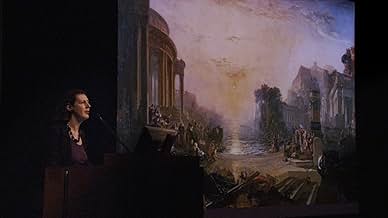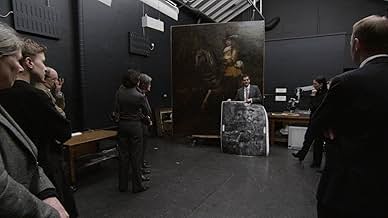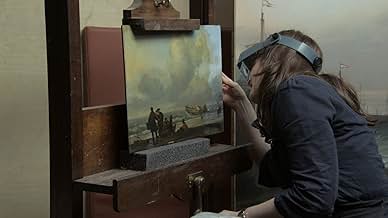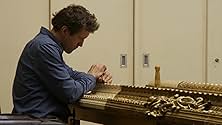VALUTAZIONE IMDb
7,3/10
1754
LA TUA VALUTAZIONE
Aggiungi una trama nella tua linguaA documentary that goes inside one of the great museums of the world: The National Gallery in London.A documentary that goes inside one of the great museums of the world: The National Gallery in London.A documentary that goes inside one of the great museums of the world: The National Gallery in London.
- Regia
- Sceneggiatura
- Star
- Premi
- 1 vittoria e 9 candidature totali
Larry Keith
- Self - director of conservation, National Gallery
- (non citato nei titoli originali)
Nicholas Penny
- Self - director of the National Gallery
- (non citato nei titoli originali)
Luke Syson
- Self - curator, National Gallery
- (non citato nei titoli originali)
Recensioni in evidenza
I was expecting three hours of viewing paintings; maybe there would be descriptions and opinions.
What we get is much more. It is a real documentary about life in London's National Gallery. I can relate as we have a local (Kimbell Art Museum) and took part in similar activities.
Do not get me wrong, there are plenty of pictures and discussions. They are just part of the overall experience.
You will come away feeling that you are part of the gallery staff and participated in decisions. It is the next best thing to being there. And the three hours presentation in its casual form will leave you wanting more.
What we get is much more. It is a real documentary about life in London's National Gallery. I can relate as we have a local (Kimbell Art Museum) and took part in similar activities.
Do not get me wrong, there are plenty of pictures and discussions. They are just part of the overall experience.
You will come away feeling that you are part of the gallery staff and participated in decisions. It is the next best thing to being there. And the three hours presentation in its casual form will leave you wanting more.
If you are familiar with Wiseman's work, you know that he is a true documentarian. No Michael Moore-type bias, no opinions, just a pure document for you to do with what you will. I enjoyed every minute and learned much about the day-to-day life in London's National Gallery. I loved the staff lectures on different paintings, the restoration sections were fascinating, and even the board meetings were interesting (even though I hate meetings in real life LOL).
I'm only sorry Frederick Wiseman is getting older and cannot be with us for another 80 years so he can make even more documentaries. Brilliant, beautiful, sublime .
I'm only sorry Frederick Wiseman is getting older and cannot be with us for another 80 years so he can make even more documentaries. Brilliant, beautiful, sublime .
For those who enjoy the experience of visiting art museums, National Gallery' is a must-see. The brilliant objectivist documentarian Frederick Wiseman captures the iconic British museum from every side imaginable. Over the course of three hours, he offers a grand glimpse of the museum's collection and temporary exhibits as others look or discuss them, from art historians to tour guides. Fixed history and interpretation are celebrated in both Wiseman's camera and the loosely strung scenes of people in the exhibition halls. The movie cuts to various perspectives of the museum, from details of paintings to entire galleries, as people gaze at works. But Wiseman also captures the people operating the museums during PR and budget meetings and, most intriguingly, at work restoring paintings. No one looks at the camera to explain their work and Wiseman never even uses superimposed title cards, yet you will come away enlightened.
For a 3 hour documentary about the National Gallery, this is oddly compelling. I'm really not sure how this got on my watch list, but I'm glad it did. I first visited the National Gallery in my mid-teens. It felt stuffy and I got bored quickly. The art didn't grab me the way things did at The Tate, but I can still recall the feeling of looking at some of those masters and although not thinking 'that looks ace', it was impressive. It's nice to see here that there's voices running the gallery that want to open the gallery to appeal more to the public. This of course being 'proper art' that everyone can think 'well that's good, I can't paint like that', as apposed to the opposite reaction levied at modern art. Not everyone wants that though, there's still the undercurrent of an elitist element present which is frustrating. Some of the nicest stuff in this is the viewers stood looking at the paintings, you experiencing their fascination through their fixation. Especially the packed crowds for the Da Vinci exhibition. The hushed walla through the rooms, people gawking and picking apart the paintings as people have done for hundreds of years. There's some really cool stuff, artwork transferred into almost Braille like pieces for the blind to enjoy, absolutely fabulous! As is the tour guide down on floor with a group of really young kids, telling them about the paintings around them, bustling with energy and enthusiasm. Not least this works simply for the explanation of the exhibits. The stories behind them bringing them to life. The restoration stuff is mind boggling too and sadly isn't covered enough, it's also ironically very much all surface with little explanation to the process... although the X-ray stuff on a Rembrandt is cool and the stuff that's not explained is still very relaxing to watch. Instead there's some behind the scenes stuff which is exceptionally dry. Unedited meetings about how they deal with the London Marathon finishing on their doorstep and how they deal with charitable requests. It's stuff like this that pushes the duration to the 3 hour mark and it's far from entertaining, but it seems the choice has been made to put it all out there for the viewer to muse over... much like the art on the walls. There's some delightful bits though, the art historian filming a piece to camera talking about a Turner, the lighting experts talking about compositions dictated by natural light before we had electricity and the bloke struggling to talk about carving ebony picture frames that reminded Anne* of Porky Pig. Depressingly in another meeting there's talk of budgets, caps on spending, staff reductions and palpable concern over what the future may bring. The figures mentioned are pretty epic, but then as art institutions go, this one is epic. It's been a while. I think I need to go back and visit again.
National Gallery (2014) was directed by Frederick Wiseman. Wiseman is also listed as writer, co-producer, and editor. Although this is obviously very much a Wiseman film, Wiseman himself never appears in it.
This is typical of Wiseman. He finds ways to go where no other cinematographer could go, and he films what he sees. Moreover, there's never a hint that people are aware of the camera's presence, and there's no voice-over. What he sees is what you get. There's no explanations and no talking heads.
Because National Gallery is about a major art gallery, this film doesn't have the sizzle and pop that occur in some of Wiseman's other documentaries. For example, Astoria (2000) is about a multi-ethnic neighborhood in Queens, NY. Naturally it's more lively and inherently more interesting than National Gallery.
However, Wiseman is a great director, and he makes a relatively quiet art gallery a place where we see quiet internal struggles, and some great discussions of the paintings themselves, and the technical aspect of restoring paintings and even of making frames.
I was very interested in the board room scenes. It became clear to me that there was a subsurface struggle between the director and most of his staff. The staff wanted to make the museum more user-friendly. For example, the U.S. National Gallery and the Metropolitan Museum in NYC are user-friendly. People from all the strata of society feel comfortable there. From context, that isn't so at the National Gallery.
The staff would like to change that, but it becomes apparent that the director is looking for middle- and upper-class attendance. If Bill Rugby doesn't feel at home at the museum, the director doesn't really care.
Nobody on the staff wants to confront him directly, so they keep agreeing with him, and then saying, "Yes, but . . . " He ignores these oblique suggestions, and he prevails.
The movie is three hours long, and there are many segments. Some segments worked really well, but some of the segments didn't work for me at all. For example, there's a special program at the gallery for visually impaired people. A lecturer has a work of art, and describes it in terms of lines and angles. The visually impaired people are supposed to "see" the painting in this way. It didn't look like any of them could, indeed, visualize the painting. And, unfortunately, this scene went on and on. It's a three-hour movie, so Wiseman could allow this scene to go on and on, but it wasn't enjoyable for me.
This isn't a movie that you should watch for excitement and revelation. On the other hand, if you love art, and art museums, it's the movie for you.
We saw National Gallery on DVD. It worked very well on the small screen.
This is typical of Wiseman. He finds ways to go where no other cinematographer could go, and he films what he sees. Moreover, there's never a hint that people are aware of the camera's presence, and there's no voice-over. What he sees is what you get. There's no explanations and no talking heads.
Because National Gallery is about a major art gallery, this film doesn't have the sizzle and pop that occur in some of Wiseman's other documentaries. For example, Astoria (2000) is about a multi-ethnic neighborhood in Queens, NY. Naturally it's more lively and inherently more interesting than National Gallery.
However, Wiseman is a great director, and he makes a relatively quiet art gallery a place where we see quiet internal struggles, and some great discussions of the paintings themselves, and the technical aspect of restoring paintings and even of making frames.
I was very interested in the board room scenes. It became clear to me that there was a subsurface struggle between the director and most of his staff. The staff wanted to make the museum more user-friendly. For example, the U.S. National Gallery and the Metropolitan Museum in NYC are user-friendly. People from all the strata of society feel comfortable there. From context, that isn't so at the National Gallery.
The staff would like to change that, but it becomes apparent that the director is looking for middle- and upper-class attendance. If Bill Rugby doesn't feel at home at the museum, the director doesn't really care.
Nobody on the staff wants to confront him directly, so they keep agreeing with him, and then saying, "Yes, but . . . " He ignores these oblique suggestions, and he prevails.
The movie is three hours long, and there are many segments. Some segments worked really well, but some of the segments didn't work for me at all. For example, there's a special program at the gallery for visually impaired people. A lecturer has a work of art, and describes it in terms of lines and angles. The visually impaired people are supposed to "see" the painting in this way. It didn't look like any of them could, indeed, visualize the painting. And, unfortunately, this scene went on and on. It's a three-hour movie, so Wiseman could allow this scene to go on and on, but it wasn't enjoyable for me.
This isn't a movie that you should watch for excitement and revelation. On the other hand, if you love art, and art museums, it's the movie for you.
We saw National Gallery on DVD. It worked very well on the small screen.
Lo sapevi?
- ConnessioniReferenced in Film Junk Podcast: Episode 493: Predestination (2014)
- Colonne sonoreSonate pour piano Op. 31 no 3
Music by Ludwig van Beethoven
Performed by Kausikan Rajeshkumar, RCM
dans la cadre de Belle Shenkamn Music Program (correct is "Belle Shenkman music programme")
[Récital]
I più visti
Accedi per valutare e creare un elenco di titoli salvati per ottenere consigli personalizzati
- How long is National Gallery?Powered by Alexa
Dettagli
- Data di uscita
- Paesi di origine
- Sito ufficiale
- Lingua
- Celebre anche come
- 歡迎光臨國家畫廊
- Luoghi delle riprese
- Aziende produttrici
- Vedi altri crediti dell’azienda su IMDbPro
Botteghino
- Lordo Stati Uniti e Canada
- 253.941 USD
- Fine settimana di apertura Stati Uniti e Canada
- 10.049 USD
- 9 nov 2014
- Lordo in tutto il mondo
- 354.971 USD
- Tempo di esecuzione
- 3h(180 min)
- Colore
- Proporzioni
- 1.85 : 1
Contribuisci a questa pagina
Suggerisci una modifica o aggiungi i contenuti mancanti























